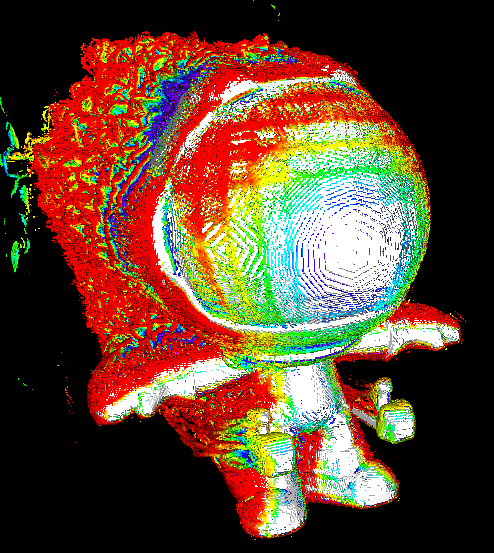Researchers at Martin Luther University Halle-Wittenberg (MLU) have discovered a new method to increase the efficiency of solar cells by a factor of 1,000. The team of scientists achieved this breakthrough by creating crystalline layers of barium titanate, strontium titanate, and calcium titanate, which were alternately placed on top of one another in a lattice structure.
Their findings, which could revolutionize the solar energy industry, were recently published in the journal Science Advances.
The headline seems to be a but misleading though. Seems like it’s 1000x more efficient than pure barium titanate would be.
Also seems like it has the potential to be much ore efficient than conventional silicon based panels, but not by a factor of 1000.Current solar panels are about 25% efficient, so 1000 times that would be 25.000%. I think Mr. Boltzmann and Mr. Maxwell might have some objections here.
In this house we obey the laws of thermodynamics!
Now that’s what I call efficient!
Thanks for clarifying that. That publication can be prone to clickbait style headlines it seems but they also publish some good information overall and I thought it was worth noting
Thanks for the reality check. Still a huge result if it translates well into mass production.
Indeed, this seems impossible. Current solar panels are surprisingly efficient as it stands.
It says in the article
compared to pure barium titanate of a similar thickness, the current flow was up to 1,000 times stronger
And in the referenced paper
In addition, the photoresponse from SBC222 is 1000 times higher than that from BTO
Neither sound like a measure of efficiency to me. But I’m also no expert and the paper went well beyond my head.
“Strong current flow” is informal language, but both it and photoresponse refer to the electrical power that comes out. In theory you would just divide that by the incoming solar flux and get the efficiency. For now it’s only in a lab setting, though, so we’ll have to see what the practical efficiency will be if this is actually incorporated into a reasonable solar cell.
So yeah, apparently barium titanate solar panels used to be extremely terrible, and now they might become competitive with further research.
It’s not a measure of efficiency per se, but efficiency is a limiting factor:
In order for a solar panel to put out 1000x more power, the baseline you’re comparing it to must be at most 0.1% efficient, because otherwise the new thing would have greater than 100% efficiency and that isn’t possible.
And that’s a purely thermodynamic argument. The actual limit for solar efficiency is likely less.
Even a few hundred percent improvement would be great.
If it’s over 400%-500%, it’s fake news, because that’d be generating more energy than is emitted by the sun (per area at distance).
There’s lots of people who are pointing out that 1000x better might be misleading, which is certainly true here, but let me be a little more exact and explain things briefly (nb I’m a prof of Materials chemistry and am involved in PV research, although it’s not my main focus). Firstly, this research does not give the efficiency which is usually the headline number*. Mainly because most of their measurement aren’t using sunlight but a laser. Here they see it does interact with light to give electricity and they show the response is 1000x higher current for their new layered materials versus the unlayered type. However, as others have pointed 1000x a low number isn’t great. The highest measured current** is 0.5 mA/cm2 although they actually do proper sunlight measurements (under 1.5 suns, which is a common way to measure this) and get 0.035 mA/cm2. This is something we can compare to commercial solar cells and it’s almost exactly 100x lower than a commercial silicon solar cell (35 mA/cm2).
Obviously there’s a lot more detail and nuance here I’m skipping over but (i) don’t expect this to change the world in the near future and (ii) its a new material approach which is cool scientifically and while the uninformed media is hyping it, the scientists in the paper were perfectly reasonable.
If you have any other questions, I’ll try to reply ASAP.
*RE efficiencies normal silicon ones are normally around 15%, good perovskite next-gem ones are a bit above 20%, and there’s a hard physical limit of 33% for a perfect single solar cell
**They use uA/cm2 because their numbers are low. I’ve converted to the more common mA/cm2. These data are in Fig 3c and Fig3d. I’d recommend you have a look yourself as there’s no paywall. https://www.science.org/doi/10.1126/sciadv.abe4206
Thanks for the details! That helps to make sense of it.
the uninformed media is hyping it, the scientists in the paper were perfectly reasonable.
Unfortunately the most common problem of science reporting. And that goes to positive and negative hype.
Thank you for debunking, it’s much appreciated!
shit, they generate more energy than they receive… move aside cold fusion
I think what they’re saying is that this new method is 1000x more efficient compared to previous solar panels made of ferroelectric crystals, not compared to the standard silicone ones. So it’s more like “previous alternative solar panel that sucked now might not suck” rather than “existing solar panels now make 1000x more power.”
Base solar panel = 14% effecient x 1000 = 14,000% effecient. The only way the math works is if the new panels are 100% efficient and they are referencing a rock as a standard solar panel. I’m calling BS.
Any domain that ends in .news is full of A-grade bullshit. Just something I’ve noticed.
Anything claiming a 1000 times improvement on a technology needs to come from several serious sources to be remotely credible
It’s a 1000 times improvement the same way riding a horse is a 1000 times improvement over riding an army of snails. It’s possible because nobody was doing the old thing because it was garbage.
Impossible to be literally true, so quite literally “incredible” if 1000x or 1000%. The sun doesn’t emit that much energy more than current solar panels can manage.
Yeah, a kilowatt per square meter (perpendicular to the sun angle). We only need something like 5 times for 100% efficiency
The article must be either entirely bullshit or using an odd baseline to raise a thousand times
Most solar panels are ~20% efficient. So (100-20)/1000=0.08%, 100-0.08=99.92% efficient (1000x less energy loss) (you could do it the other way, but that would make less sense)
Sounds an awful lot like an article posted months ago. Old article? Someone publish a copy of an old article?
And yeah, those numbers are 1000% bogus.
When conducting the photoelectric measurements, the new material was irradiated with laser light. The result surprised even the research group: compared to pure barium titanate of a similar thickness, the current flow was up to 1,000 times stronger, despite the fact that the proportion of barium titanate as the main photoelectric component was reduced by almost two thirds.
Hm, no words about real efficiency compared to existing tech nor reciclability and other less important factors than 1,000x better efficiency.
This would finally make solar feasible in Puget Sound! Assuming it’s true, and will become available during my lifetime. Well, it would still make solar feasible in Puget Sound even if I were dead, but I wouldn’t get to enjoy it.
Can we not also combine this type of panel with the algae ones? I dunno how pointless that would be tbh.






